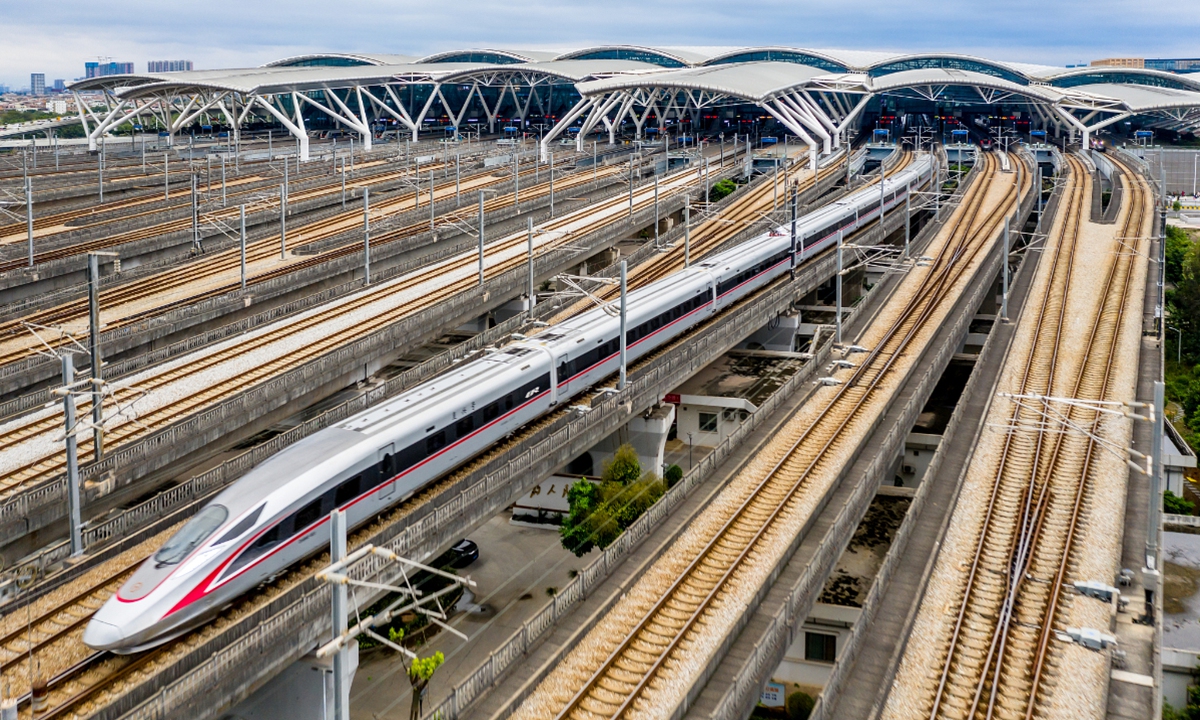
Photo:VCG
In 2024, the operating mileage of China's high-speed railway has exceeded 46,000 kilometers, nearly 30,000 miles. Unsurprisingly, some Western media outlets have slandered China's high-speed railway, questioning the necessity of such an extensive network. They cannot accept the remarkable advantages of China's high-speed railway system in terms of technology, construction efficiency and quality. Their purpose is nothing more than to smear China's development achievements and attempt to "regain respect" for Western countries in the field of global infrastructure construction by belittling others. In light of reality, such smears are absurd.
In the late 20th century, China proposed a vision for high-speed rail. After 2000, the construction plan was launched and put into action. In just over 20 years, China has developed the world's leading high-speed railway network, with high-speed railway mileage increasing from 0 to 46,000 kilometers, ranking first in the world. It is the only country to have realized commercial operation of high-speed railway at 350 kilometers per hour. The total operating railway mileage has exceeded 160,000 kilometers, of which the high-speed railway mileage has surpassed 46,000 kilometers, an increase of 64.2 percent and 392.2 percent, respectively, compared to the end of 2012.
It has been proven that high-speed rail is a crucial "accelerator" for China's economy. As a large-scale infrastructure project, high-speed rail construction involves substantial investments in areas such as construction materials, machinery and electrical equipment, thereby significantly boosting these sectors. The considerable financial input not only directly promotes the development of upstream and downstream industries and creates numerous job opportunities, but also plays a significant role in stabilizing economic growth. According to statistics, every 100 million yuan ($13.8 million) invested in high-speed rail can directly generate around 300 million yuan in investments in industries such as metallurgy, construction and manufacturing, creating over 2,200 jobs. Additionally, high-speed rail construction drives technological innovation and upgrades in related sectors. Traditional industries like steel, cement and machinery manufacturing have continuously upgraded their technology and processes to enhance product quality and production efficiency.
Furthermore, high-speed rail generates remarkable exports. Statistics indicate that high-quality Belt and Road cooperation includes 26,300 kilometers of high-speed rail, accounting for 28.3 percent of the global high-speed rail construction plan and 76 percent of the total overseas high-speed rail mileage that China is expected to participate in. 2024 marks the first anniversary of the Jakarta-Bandung High-Speed Railway in Indonesia since its operation, having already transported over 330,000 foreign passengers from 159 countries and regions.
In May 2024, the number of tourists in West Java surged by 94.84 percent compared to the previous month, while the number of visitors to Bandung increased by 10 to 15 percent this year. The Jakarta-Bandung High-Speed Railway has partnered with more than 10 tourism attractions in Bandung, significantly boosting hotel occupancy rates and restaurant revenues in the surrounding areas. According to official Indonesian data, between 2019 and 2023, the Jakarta-Bandung High-Speed Railway project contributed approximately 86.5 trillion Indonesian Rupiah ($5.4 billion) to the GDP of Jakarta and West Java.
Looking forward, there is immense potential to be tapped in China's high-speed rail. Many cities have yet to be connected by high-speed rail. More railways are being constructed in economically developed and densely populated regions in southeastern China. As the development pattern characterized by metropolitan circles and urban agglomerations takes shape, city-level railways connecting major cities with surrounding areas are becoming one key focus of future railway construction. Adhering to the development of high-speed rail is a firm choice that aligns with China's development strategy and practical needs.
The author is a researcher at the Beijing Open Economy Research Institute, University of International Business and Economics. opinion@globaltimes.com.cn




